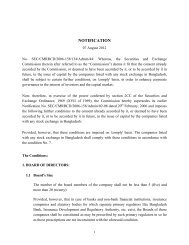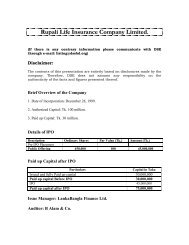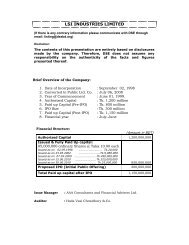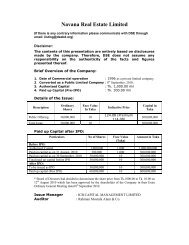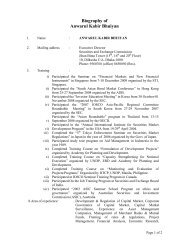Information Document - Dhaka Stock Exchange
Information Document - Dhaka Stock Exchange
Information Document - Dhaka Stock Exchange
- No tags were found...
You also want an ePaper? Increase the reach of your titles
YUMPU automatically turns print PDFs into web optimized ePapers that Google loves.
C. DESCRIPTION OF THE BUSINESS:<strong>Information</strong> about the Company• BackgroundIn 1997 the Bangladesh Power Development Board (BPDB) was faced with the challenge to ease acritically short power supply in the South Western Zone of Bangladesh. The electrical demand hadbeen consistently higher than available capacity, and generation costs in the area had been veryhigh due to the low efficiency of existing equipment and the heavy use of expensive, lowavailabilityfuel. In October 1997, BPDB signed a Power Purchase Agreement with Khulna PowerCompany Ltd. for a 110 MW floating base load power plant at Khulna, to help ease the electricityshortage.• DescriptionKhulna Power Company Ltd. is a public limited company which was incorporated as a privatelimited company in Bangladesh on October 15, 1997. Its paid up capital is BDT 2085.93 million (US$44.10 million) It is the first independent 110MW barge-mounted power plant that commencedoperation in October 1998 under a 15 year PPA from the government (expiry 2013). Whenestablished, KPCL shareholders were Coastal Power Company (later Coastal was merged with ElPaso Corporation, USA) through its direct wholly-owned subsidiary El Paso Khulna Power ApS,Summit Industrial & Mercantile Corporation (Pvt.) Ltd. (Bangladesh), United Enterprises & Co Ltd.(Bangladesh) and Wärtsilä Development and Financial Services (Asia) Ltd. Now only localshareholders hold 100% ownership of the company. KPCL project was initially financed by the IFCand the sponsors’ equity with a debt-to-equity ratio of 54:46. The total initial project cost was USD96.07 millionThe principal activity of KPCL is to own and operate barge mounted power plants in Khulna andsupply electricity to the national grid of Bangladesh. The plant came into operation in October1998. Nine engines generators are mounted on one barge and ten on the other. The barges, shippedas deck cargo on a submersible dry tow ship, are moored in a closed basin. Each barge isapproximately 91 meters long and 24 meters wide. These two barge-mounted plants wereconnected to the national grid. The plant consumes about 600 MT of Heavy Fuel Oil daily togenerate 110 MW power by the 19 generators on the two barges located in Khalishpur, Khulna.The project was the first IPP implemented under the then new Government of Bangladeshguidelines for private power projects. As Bangladesh has enjoyed steady growth in recent years, theinfrastructure to supply electricity to the economy has not kept pace with this growth. Reliabilityof electricity supply, which has been a growing problem over the years, has now reached crisisproportions. Peak demand is about 5500-6000 MW, whereas available generation is about 4200-4500MW. The demand supply imbalance has now become a major bottleneck to economic growth. TheKhulna power project is a fast-track response to the power shortage.KPCL plant was designed to alleviate the severe power shortages in the Khulna and adjacent areas,identified as industrial growth Centres by the Government of Bangladesh, while improving theoverall reliability of the country's power supply. The facility displaced the generating capacity ofthe older, less efficient, and high-cost plants in the region. The plant conformed to all applicableenvironmental standards.The plant has already changed the economy of the adjacent region directly and positively. It hasprovided employment to over 110 people from the surrounding areas and many of the jobs aretechnical and managerial in nature. Significant numbers of jobs have been created at the fuelterminal, barges, restaurants, transportation services, and other ancillary businesses created toserve the needs of the plant. New industrial and commercial establishments have been opened totake advantage of the stable and reliable power, and existing establishments do not require backupgenerators. In addition, the plant has contributed significant funds toward social causes in theregion.10



